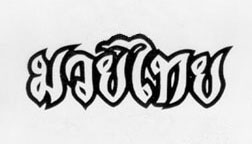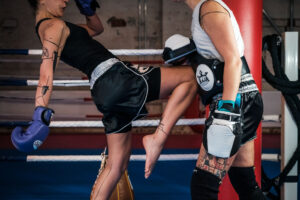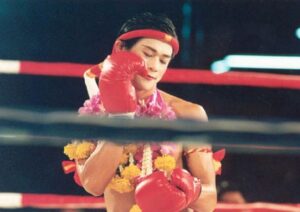About Muay Thai
„Thai boxing consists of the qualitites of obedience, genuine knowledge, courage, endurance, patience, compassion, gratitude and honesty. If any one of these qualities is missing, to use the words ‚Thai boxing‘ is to act against the genuine art.“ (Kraitus & Kraitus: Muay Thai. The most distinguished art of fighting)
„A real boxer will never bully or intimidate anyone […] In order to be a distinguished boxer, it is imperative to look at and be aware of oneself […] One should know the weak points, important points or fatal spots.“ (Kimseng Taveesith – Boxing master during the reign of King rama VI)
Muay Thai Style

Muay Thai is the national sport of Thailand and a full-contact sport. It is also known as the “art of the eight limbs” or “art of the eight basic weapons”, as there are eight different body parts that are used: Fists, elbows, knees and kicks with the legs.
It used to be possible to throw headbutts, but this is forbidden in the modern form. Thai boxing is mainly characterized by elbows, knee techniques, shin kicks (to the thigh, ribs or head) and clinching. Clinching is so close that only elbows and knee strikes are used and Thai boxers are allowed to throw themselves to the ground. Knees to the head are not permitted in Germany.
Training is done barefoot and with boxing gloves, sometimes with additional protection. There is one basic position in Thai boxing, which is reversed for left and right-handers. The legs are about shoulder-width apart and the Thai boxer moves on the balls of their feet. When running, the Thai boxer remains in this position and does not cross their legs. The hands are held at face level ready to cover or attack at any time.

All kicks, punches and defenses are connected to the breathing and are linked to a body or hip rotation, from which the impulse for the respective technique comes. This makes it possible to put the power of the whole body into the punch/kick. It is important to first learn the correct execution of the movements. Only when this technique can be applied correctly can power and speed be used. Accordingly, training for beginners in Thailand initially consists of sandbag training before training with partners.
Muay Thai trains skills such as precise movements, exact execution, speed, reflexes, responsiveness, adaptability, coordination, balance, stamina, strength endurance, flexibility, rhythm, decisiveness, dealing with fear, dealing with pain and the correct use of breathing.
Advanced Thai boxers also train free fighting, or sparring. Protective equipment consisting of shin guards, knee pads, possibly groin guards or chest protectors, elbow pads, gloves, mouth guards and possibly head protection is worn to avoid major injuries. Sparring prepares you for competition situations, but can also be practiced on its own for training purposes.
Muay Thai Story
Muay Thai has developed over at least 2000 years from traditional martial arts in Asia and is linked to the migration of the Thai people (“the free”) to present-day Thailand from the 12th century onwards. It is assumed that the Thais defended themselves against the neighboring tribes and that Muay Thai had long been part of their military training. The body was used for fighting when weapons such as swords and spears could no longer be used.
It is not possible to make any definite statements about the exact origins of Muay Thai, as many documents were burned in the State Library during the war in Ayuthaya in 1767. Records carved in stone dating back to 1219 bear witness to the warfare of the Thais against Cambodia. Over the centuries, there have been several reigning kings who have promoted the development of the arts of war. From the 17th century onwards, fights were held for the entertainment of the population. The competing boxers did not yet wear boxing gloves, but only 5-meter-long bandages (Kard Cheurk) and coconut shells as deep protection. The fighting area was fenced off with a cotton rope. The fighters wore their mong-kon and pra jead (see below). In those days, fights were decided by surrender or knockout.
Training back then consisted of long-distance running, swimming and punching and kicking tree trunks to strengthen fists and legs. The diet was largely vegetarian. The techniques from this time were passed down through the generations, improved and developed from the war zone into the sport we know today.
The first boxing ring was built in 1921 and today’s standard size is approx. 6 x 6 meters on the inside of the ring. Judges are used and victory is still decided by knockout or surrender. The coconut shell as a groin guard is replaced by a sturdy cotton guard. Rounds are measured with a clock for the first time. Previously, a coconut shell with a hole in it was used and the contestants waited until it sank into a container of water – this ended each round.
Nowadays, Muay Thai is recognized as a world heritage site. It is a popular sport practiced by most people in the West for purely sporting reasons. In the last 50 years, international rules for amateur Muay Thai have been established and various national and international federations have been founded.
Nak Muay Ying (Female Fighters), Transgender Fighters
There is hardly any documented knowledge about female Thai boxers, only oral traditions, which are very imprecise, especially before 1997. It is assumed that they have been fighting in the provinces for a very long time, but have been historically ignored. The president of the Muay Thai Institute, Amnuay Kesbumrung, organized professional women’s fights in the well-known Lumpini Stadium from the late 1960s. After a few years, he stopped this attempt as no male spectators supported these fights and they did not place any bets. In the following decades, female Thai boxers were only seen at local temple festivals and village festivals.
Around 1997, Kesbumrung built an official stadium, Rangsit, which has two gender-segregated rings and a training camp. In addition, from the early 1990s, more and more women from the West came to Thailand to fight where the sport originated. They were well trained and faced poorly trained Thai female Thai boxers whom they outclassed. It is believed that this humiliation of being defeated by foreign women in their own national sport led to Thai women becoming all the better trained and their Thai boxing skills have since increased significantly. The number of female Thai boxers is increasing both in Thailand and worldwide.
Female fighters in Thailand are mostly under the age of 18, as this is when they have the best opportunities to train and fight alongside school. After school, they usually have to study, start a family or work. The hotspot for female fighters is Chiang Mai, where there are several sports schools for training but also gyms that are only for women or have a high female quota. In the biggest Muay Thai medium “Muay Siam” there is a weekly column on female fighters and the Thapae Stadium in Chiang Mai has 2/7 fights between women at every event. Sometimes there are also complete evenings with female fighters at Thapae.

In addition to the only female Thai boxing promoter in Thailand, there are several transgender people who get into the ring to finance their hormone therapy. The story of Nong Toom is told in the movie “Beautiful Boxer”. In 2017, a trans male Thai boxer was allowed to fight in the Lumpinee Stadium for the first time. But women are still not allowed to fight in Thailand’s most important boxing rings, Lumpinee and Rajadamnern (both in Bangkok). Yet the goal of most young fighters is to get into the ring there one day. For female Thai boxers, this means that they cannot become as well-known as male fighters, fight for lower-ranking titles and receive less money (around ¼ of the prize money).
In some stadiums, women are not allowed to touch the boxing ring, as it is assumed that they are generally unclean due to menstruation and could therefore break the spells around the ring. For the same reason, they have to pass under the lowest ring rope and are only allowed to put on their mongkon in the ring. They are also not allowed to touch other people’s mongkon, only their own. Men may climb over the top ring rope.
Competitions
Thai boxing as a competitive sport became particularly important from 1921, when the first stadium was built under King Rama VI. The fighters only wore bandages, but boxing gloves were used for the first time in 1929.
Before the competition, the fighters enter the ring adorned with a headband (mong-kon) and a band on one or both upper arms (pra jead). The mong-kon is traditionally handmade and is said to bring luck and protection to the Thai boxer. The pra jead was originally a piece of cloth that was torn from the mother’s clothing (usually from the sarung) and, depending on the fighter’s goal, was given a prayer by a monk, e.g. for better defense or speed, or simply to bring good luck and protection.
The audience is greeted in the ring and then a ritual is performed that looks like a dance. At the beginning of the so-called “Wai Khruu”, respect and gratitude is shown to the trainer for teaching Thai boxing. The parents are also thanked for having been given the gift of life. Wai Khruu translates roughly as “chasing fear from the heart”. With this dance, the Thai boxer prepares for the upcoming competition. Before the fight begins, the Mong-kon and Pra Jead are taken. The styles of Wai Khruu and Mong-kon traditionally enabled the audience to recognize which region the fighter comes from. Nowadays this is no longer possible.
A Thai boxing-specific music is played, the Sarama (or Wong Pee Glong), which rhythmically accompanies the Wai Khruu, but also the fight itself. In Thailand, the sarama is played by a live orchestra of four musicians with two flutes and two Thai drums. They can respond to the fight atmosphere live and play faster and louder when the fight becomes more intense towards the end. In large stadiums, the music is played over loudspeakers. The fights are 2-5 rounds of 2-3 minutes each – depending on the league.
Popularity in Thailand
Thai boxers are respected and honored idols in Thailand, similar to soccer players in the West. The fighters have individual nicknames, which they are given by their trainer after their first fight. The name gives an indication of the Thai boxer’s characteristics (e.g. speed) and has a connection to the gym where he or she trains.
Thai boxing is so popular in Thailand that competitions are broadcast live on television several times a week. It is very common to place a bet on the fighters, making it all the more exciting to see who will win. The competing Thai boxers receive a share of the bet. In many families, the youngest children are trained in Thai boxing from an early age. As bets are also placed on children’s fights, they are often already responsible for providing part of the family income with their fights as children and teenagers. It is not uncommon for them to end their career at the age of around 20 and then work in a gym where Thai boxers from the West come to train.
Ressources
Blog by Sylvie von Duuglas-Ittu https://8limbsus.com
https://news.muayfarang.com/2019/01/03/nak-muay-yings-female-fighters-in-thailand/
https://www.themuse.com/advice/fight-like-a-girl-the-role-of-women-in-muay-thai-boxing
http://fightland.vice.com
Panya Kraitus, Dr. Pitisuk Kraitus: Muay Thai. The most dinstinguished art of Fighting
Website of Muay Thai Bund Deutschland: https://mtbd.de
https://de.wikipedia.org/wiki/Muay_Thai
https://fightrr.com/muay-thai/why-do-muay-thai-fighters-wear-armbands
Muay Thai (as well as other martial arts) has become very popular in feminist circles in recent years. A nice “side effect” of Thai boxing is that body awareness improves significantly and the sport can have a positive effect on a more self-confident appearance. There were already some self-organized groups in the 1980s. In recent years, many professionally run feminist groups have emerged as part of various clubs, as well as several FLINTA*-only martial arts clubs.
